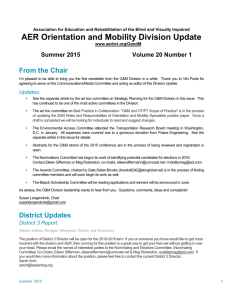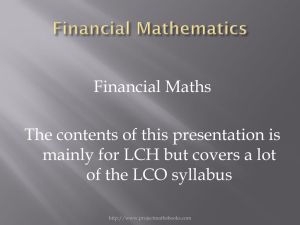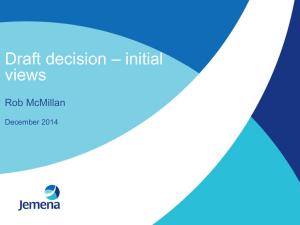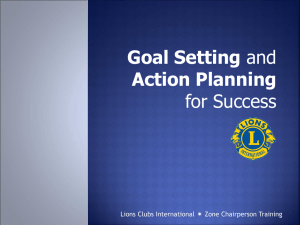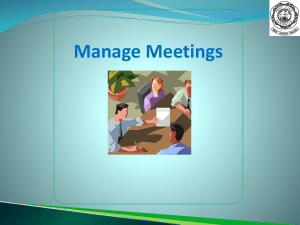March 30, 2015 - Orientation and Mobility Division
advertisement
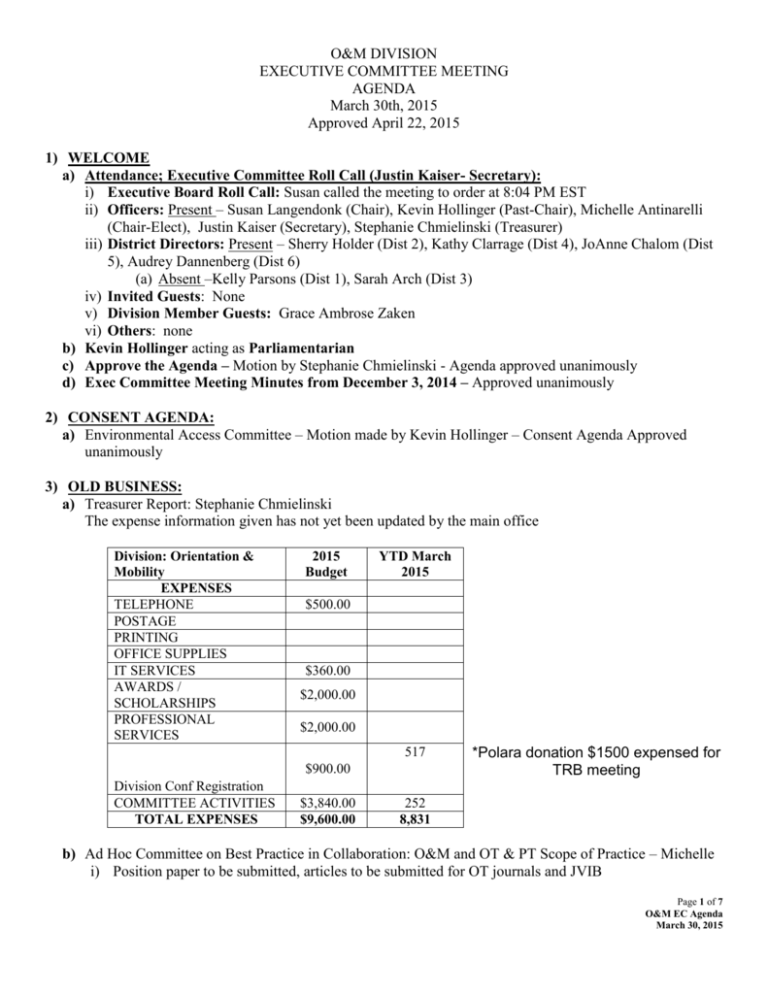
O&M DIVISION EXECUTIVE COMMITTEE MEETING AGENDA March 30th, 2015 Approved April 22, 2015 1) WELCOME a) Attendance; Executive Committee Roll Call (Justin Kaiser- Secretary): i) Executive Board Roll Call: Susan called the meeting to order at 8:04 PM EST ii) Officers: Present – Susan Langendonk (Chair), Kevin Hollinger (Past-Chair), Michelle Antinarelli (Chair-Elect), Justin Kaiser (Secretary), Stephanie Chmielinski (Treasurer) iii) District Directors: Present – Sherry Holder (Dist 2), Kathy Clarrage (Dist 4), JoAnne Chalom (Dist 5), Audrey Dannenberg (Dist 6) (a) Absent –Kelly Parsons (Dist 1), Sarah Arch (Dist 3) iv) Invited Guests: None v) Division Member Guests: Grace Ambrose Zaken vi) Others: none b) Kevin Hollinger acting as Parliamentarian c) Approve the Agenda – Motion by Stephanie Chmielinski - Agenda approved unanimously d) Exec Committee Meeting Minutes from December 3, 2014 – Approved unanimously 2) CONSENT AGENDA: a) Environmental Access Committee – Motion made by Kevin Hollinger – Consent Agenda Approved unanimously 3) OLD BUSINESS: a) Treasurer Report: Stephanie Chmielinski The expense information given has not yet been updated by the main office Division: Orientation & Mobility EXPENSES TELEPHONE POSTAGE PRINTING OFFICE SUPPLIES IT SERVICES AWARDS / SCHOLARSHIPS PROFESSIONAL SERVICES 2015 Budget YTD March 2015 $500.00 $360.00 $2,000.00 $2,000.00 517 $900.00 Division Conf Registration COMMITTEE ACTIVITIES TOTAL EXPENSES $3,840.00 $9,600.00 *Polara donation $1500 expensed for TRB meeting 252 8,831 b) Ad Hoc Committee on Best Practice in Collaboration: O&M and OT & PT Scope of Practice – Michelle i) Position paper to be submitted, articles to be submitted for OT journals and JVIB Page 1 of 7 O&M EC Agenda March 30, 2015 ii) Issues with licensure possibilities, OT scope and practice, determining what the field wants – Susan iii) Present O&M Scope of practice to OT/PT graduate students – Audrey iv) Possibly recruit OT/PT students that don’t get into schools c) Ad Hoc Committee on Division Strategic Planning, Goals and Initiatives – Kevin i) The Ad Hoc Committee for Strategic Planning and Division Initiatives continues to move forward with the information gathering phase of our charges. The team members and select other Division members have and are presenting at various conferences by moderating roundtable discussions. We will start contacting those participants at the roundtables who indicated they may like a follow-up from this committee. The goal of the Committee remains to have some concrete plans and initiatives ready for discussion at the AER 2016 in Jacksonville with the projected unveiling at the O&M conference in 2017 in Pittsburgh. Our Division leadership continues to work hard and collaboratively with our fellow members representing the Summit Group. The committee continues to learn many AER and non-AER members still confuse ACVREP with AER. The end result of the committee's work may be influenced by other trends in the field, including, but not limited to: proposed changes to the name of the degree or title of O&M Specialists; AER's pending, planned or revisited alliances with associated agencies/organizations; impact of the healthcare company recruitment and contractual services, and any progress with licensure in various states ii) AER O&M Division membership down over last 6 months - Susan d) IMC15 - Susan i) Poster Presentation accepted for conference 4) NEW BUSINESS: a) Nominating Committee – Eileen Sifferman a. Start talking about nominations, Eileen and Meg Robertson co-chairs b) Scholarship Committee a. Scholarship application is available, must be AER approved programs c) Awards Committee a. Start thinking about awards for next year b. Need chair for committee c. Change how the awards ceremony is presented, organized, and promoted d) Inactive Committees a. Should fall into place once the strategic planning initiatives become more clear e) Grace Ambrose-Zaken request a. Is this the role of the O&M Division? b. Looking at the literature in the history of O&M and trying to define what O&M is and if there should possibly be a change to O&M with a visual impairment (O&MVI) c. Executive committee suggested this be part of the discussion of the strategic planning committee going forward 5) District Updates DISTRICT 4: Kathy Clarrage Will present at NEAER in November DISTRICT 6: Audrey Dannenberg – attended VA AER conference in Fairfax. Session on Blind Square should be presented at other conferences if it hasn't been. UMass Boston is working on consortium with George Mason Univ for adding mobility. Hiring 3 O&M'ers to teach methods course- actual cane training in their regions. will be attending MI AER to present on recruitment as Susan invited me. Penn Del AER which I had hoped to go to conflicts with MI AER. Page 2 of 7 O&M EC Agenda March 30, 2015 need names of potential recruitment coordinators from Chapters you represent started advertising for filling of District 6 position From the Floor: None 6) ADJOURN Motion to adjourn at 9:57 PM – Motion passed Page 3 of 7 O&M EC Agenda March 30, 2015 O&M DIVISION DISTRICT DIRECTORS and COMMITTEE CHAIRS DISTRICT 1: Kelly Parsons (Alaska, Alberta, Arizona, British Columbia, Colorado, Hawaii, New Mexico, California, Nevada, Idaho, Montana, Wyoming, Northwest Territories, Oregon, Utah, Washington, Yukon Territories.) DISTRICT 2: Sherry Holder (Arkansas, North Dakota, South Dakota, Iowa, Kansas, Louisiana, Manitoba, Missouri, Nebraska, Oklahoma, Saskatchewan, Texas.) DISTRICT 3: Sarah Arch (Illinois, Indiana, Michigan, Minnesota, Ontario and Wisconsin.) DISTRICT 4: Kathy Clarrage (Connecticut, Massachusetts, Maine, New Brunswick, Newfoundland, New Hampshire, New York, Nova Scotia, Prince Edward Island, Quebec, Rhode Island, Vermont) DISTRICT 5: JoAnne Chalom (Alabama, Florida, Georgia, Kentucky, Mississippi, North Carolina, South Carolina, Puerto Rico, Tennessee) DISTRICT 6: Audrey Dannenberg (Delaware, Maryland, New Jersey, Ohio, Pennsylvania, Virgin Islands, Virginia, West Virginia, Washington D.C.) COMMITTEES I. II. III. IV. V. VI. VII. VIII. IX. X. XI. XII. Archives Committee (Chairperson – Rod Kossick) – Awards Committee (Chairperson – TBA Members: Past Chair Kevin Hollinger, Chair-Elect – Michelle Antinarelli) Communications / Media (Chairperson – Viki Poole) – Environmental Access Committee (Chairperson – Janet Barlow) – Finance Committee (Chairperson – Treasurer (Stephanie Chmielnski)) International Committee (Chairperson – Dr. Laura Bozeman) – Membership Committee (Chairperson – ) – Meredith Griffin Nominating Committee (Chairperson – Eileen Sifferman/Meg Roberston ) Professional Issues Committee – a. Chair Elect Michelle Antinarelli b. Dr. William Wiener c. Dr. William Penrod Program Committee – 2016 IAER (Chair - Michelle Antinarelli) Program Committee – 2017 O&M Division (Chair – Susan Langendonk) Scholarship Committee (Blasch) (Chairperson – Dr. Danene Fast) – Page 4 of 7 O&M EC Agenda March 30, 2015 CONSENT AGENDA REPORTS Environmental Access Committee report 3/27/15 Janet Barlow, Chair jmbarlow@accessforblind.org EAC members have continued to try to provide updated information in their various regions, particularly fielding a number of questions about how to request and advocate for accessible pedestrian signals (APS), and questions on proper installation of APS and detectable warnings. A recent concern for committee members is how to get Orientation and Mobility Specialists in the field to teach accurate and up-to-date information about actuated traffic signals and the appropriate use of pedestrian pushbuttons. Our main activity last quarter, though, was attendance at the meeting of the National Committee on Uniform Traffic Control Devices (Beezy Bentzen) and at the Annual meeting of the Transportation Research Board (Janet Barlow, Beezy Bentzen, Lukas Franck, Meg Robertson, Dona Sauerburger). These are meetings of traffic engineers and transportation planners, many of whom have never heard of Orientation and Mobility Specialists and our goal is to continue to raise awareness of issues affecting travelers who are blind or who have low vision and to encourage designs and practices that improve access and safety. National Committee on Uniform Traffic Control Devices—Arlington, VA, January 7-9, 2015 The National Committee on Uniform Traffic Control Devices (NCUTCD) is a group representing various organizations interested in traffic control that makes recommendations to the Federal Highway Administration for changes to information in the Manual on Uniform Traffic Control Devices (MUTCD). The NCUTCD meets twice each year, in January and June. Beezy is an individual member of Signals Technical Committee of the NCUTCD and helps develop proposed language about traffic signals. When Signals Technical approves new or revised language, it is sent out to the NCUTCD sponsoring organizations for comments. Comments are acted upon by Signals at the next meeting, and then changes are considered by the full Council. If approved, the revised language is sent to the Federal Highway Administration’s MUTCD team to be considered for inclusion in the next edition of the MUTCD. At this point, the next revision is expected to be published in 2016. Janet is an actively participating non-member, as is Lukas. Because they are not members of specific technical committees, they are free to participate in any committee that is actively considering an issue that affects travelers with visual impairments. Neither Janet nor Lukas was able to attend this past January, however. During that meeting in his “goodbye” speech, a retiring member stated that his work with us and with individuals who are blind to add language on APS was one of the two things he was most proud of in his 40 years on the Committee. Issues that were being worked on this year included making sure that priority signal strategies for transit vehicles couldn’t shorten the time for pedestrians to complete their crossings (pedestrian clearance times). We are also working toward a requirement that there be an audible information device where there are pushbuttons to actuate flashing yellow beacons. The audible information device may be a lot like an APS. It should have a pushbutton locator tone, so a person who is blind will know it is there, and speech message that says “Yellow lights are flashing” when the button is pushed and the yellow lights begin flashing. Page 5 of 7 O&M EC Agenda March 30, 2015 The MUTCD has permitted passive pedestrian detection to be used to actuate pedestrian signals, including APS, since 2000. (In passive detection, the pedestrian is detected by a technology such as microwave or video, and pedestrians don’t have to push a button to get a walk signal.) Now it is possible to actuate the APS pushbutton locator tone using passive detection, and some people think this may be a good way to reduce the noise of locator tones. We are working to make sure that if locator tones are actuated by passive detection, they are required to come on and be audible to approaching pedestrians when the pedestrians are no less than six feet from the relevant pushbutton. It is quite complex to make passive detection and APS work well together, so we are also proposing research on whether this has any unintended adverse consequences for visually impaired travelers. Transportation Research Board (TRB)—Washington, DC, January 11-15, 2015 The Transportation Research Board (TRB) Annual meeting is held in Washington, DC each January and attended by more than 11,000 people, mainly traffic engineers, transportation planners and researchers from all over the world. There are hundreds of presentations and workshops on issues ranging from asphalt (we don’t go to those) to traffic signals to transit scheduling. Janet led a workshop this year titled “Look right! Look left! Where? Accommodating Pedestrians at Alternative Intersections” with active participation from participants in developing a list of research needs related to pedestrians and some new types of intersection designs. In addition to presentations, over two hundred TRB committees meet during the Annual Meeting. The task of those committees is to: “identify research needs; provide information to the transportation community on research priorities and procedures; review papers for presentation at the TRB Annual Meeting and for publication; encourage the incorporation of appropriate research findings into practice; and develop special programs, conferences, and workshops”. A short list of committees attended this year by EAC members include: Pedestrians, Geometric Design, Accessible Transportation and Mobility, Work Zone Traffic Control, Traffic Control Devices, User Information Systems, Traffic Signal Systems, Safe Mobility of Older Persons, Roundabouts, Visibility, and the Intersections Joint subcommittee. By participating in committees, we help shape the research agenda in each area, and advocate for and help arrange for workshops and sessions related to transportation factors affecting pedestrians with visual impairments. Anyone can attend and speak up at any committee meeting although it can be daunting at times and their agendas are quite packed. Members of the EAC are members of a few committees (Pedestrians, Roundabouts, Accessible Transportation and Mobility), and are very active participants in others. A few particular examples of our participation: Dona was able to tell the Older Persons’ Mobility Committee about AER's Conference on Vision Loss in Older Adults & Veterans (in Norfolk November 4-6), and several people came up afterwards to find out more about it. Page 6 of 7 O&M EC Agenda March 30, 2015 After a presentation of the Older Persons and Mobility committee, Meg was able to speak and recommend that they put together suggestions to help people know when they need to stop driving Janet shared information from the workshop on Alternative Intersections at the Pedestrians Committee and at the Intersections Joint subcommittee and is on a workgroup to develop a research problem statement regarding needs of pedestrians, and particularly visually impaired pedestrians, at alternative intersections. Beezy worked with two transit committees to get assistance and support for research proposals on guidance surfaces and wayfinding in transit stations. Ongoing research on accessibility of roundabouts and channelized turn lanes was discussed at the Roundabout Committee meeting and Lukas talked with a FHWA representative about researching and standardizing sound making materials on roadways. First time observations from Meg: “Thanks to the O&M Division & EAC committee, I was able to attend my first Transportation Research Board meeting this past Jan. We were in meetings from 7am to sometimes 9:30 at night! The one take away, I'm sorry to say, is the lack of understanding these professionals have regarding how individual's access to the community is impacted by vision loss. Even in the sessions which focused on the needs of older individuals, there was very little awareness or discussion on these sensory issues. There is a great need for our profession to attend these meetings and speak up at them so the environments they are designing won't negatively affect our consumers.” There are a number of reasons why participation of O&Mers in these meetings is valuable to the orientation and mobility profession and to people who are visually impaired. We are able to: 1) remind attendees that there are visually impaired individuals traveling on the streets they design; 2) suggest research on issues of importance or add questions that may address needs of people who are blind or visually impaired; 3) call attention to the relevance of the topics for people with visual impairments; 4) increase visibility of our profession among those who are designing and operating sidewalks, intersections and transit systems; and 5) take advantage of opportunities for individual follow-up from traffic engineers or planners who heard us introduce ourselves at committee meetings and want more information for a specific project in development in their city. We have made progress in getting transportation researchers and professionals to realize that what they do has consequences for travelers who are blind or who have low vision; some of this is due to the active and vocal participation of O&M Specialists in TRB activities. We continue to influence the direction of research and the topics addressed at conferences by our participation in TRB. We’d like to again express our appreciation to the O&M Division for their support of our registration costs for TRB, Lois Thibault and Jacques Peters for providing a place for some of us to stay, and to Polara Engineering for assistance with transportation and other expenses at both meetings. Page 7 of 7 O&M EC Agenda March 30, 2015
